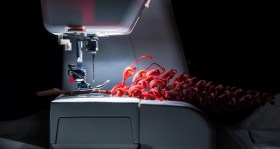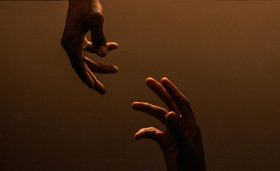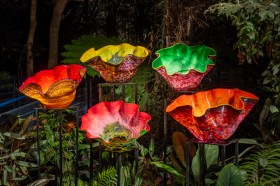For Aristotle, the great Greek philosopher of the 4th century BCE, ‘time’ was the measure of change; he saw the world in the context of events and processes in which everything was in a constant state of flux.
In his current Australian exhibition, Middle of a Moment, Aki Onda, the Japanese multidisciplinary artist, plays with this notion of time through the intersecting of the ephemeral, sound and memory, with the physical, the materiality of the world: this survey exhibition presenting some of Onda’s major installation artworks is a multisensory experience and draws from a range of mediums such as photography, music and film to performances pieces.
Showing at The Substation gallery, an imposing neoclassical brick building, originally an electrical substation in Melbourne’s inner western suburb of Newport, it is known for its focus on the contemporary and experimental – its interior spaces divided into a series of smaller galleries over two levels.
Entering the first space viewers are struck by the curatorial minimalism. It’s a simple rectangular room with a plinth on which a pile of folded visitor information pamphlets sit containing two essays: Marcus Boon’s Wave Spaces exploring energy and sound waves, and Moment to Moment by curator Lawrence English contemplating memory and time. It becomes clear that to fully appreciate Onda’s work one requires time, space and contemplation.
On one wall a series of photographs of the cosmos, spliced and reassembled draw the viewer beyond themselves to something greater – the spliced sections creating a patterning, a rhythm, a ‘music of the spheres’ perhaps and this patterning is reflected by the cassette tapes arranged on the wall opposite. A musical score of cassettes in which colour and spacing could denote rhythm and harmony.
Onda’s Cassette Memories, acting as a kind of sonic diary, are part of an ongoing project that began in 2004 and draws from decades of field recordings from which he composes, or improvises, a kind of ‘expanded music’ for his performances and musical collaborations. Like memory and feeling, the auditory is able to capture another facet of the fleeting elements of existence.
In an adjacent room Stack Until it Falls Down, a 17-minute film created during COVID-19 lockdown, is a poetic response to the repetitive experience of existence in quarantine and the acceptance of relinquishing control over something greater than ourselves. Collaborating with filmmaker Moko Fukuyama and sound designer Daniel Neuman, the piece was shot at Hurricane Point, a small island originally formed from Hurricane Sandy debris, where two currents meet along the East River with the hustle and bustle of the Brooklyn shoreline in the distance.
The film follows Onda as he mindfully stacks rocks of varying shapes and sizes in an arc around the tiny island, tolerating the vagaries of the elements as small towers are formed, knocked down and reformed again. It’s a picture of life’s rhythm at this time and a quiet meditation of man’s relationship with the natural world.
Nam June’s Spirit was Speaking to Me (2017/2022), a room installation work, is also a piece that evolved by chance. At a time when Onda was immersed in the performance of the late video artist’s work while visiting South Korea, he unexpectedly tuned into a frequency of sound one evening that seemed like human speech. Making recordings from his hotel room and later other locations, these experiences led him to believe Nam June Paik’s spirit was communicating with him.
Long shadows streak the floor of the darkened room where two screen images of Paik illuminate the space. Amid a background of static radio transmission another screen captures the sound waves, disrupting the silence and creating a playful if slightly unnerving connection to an ethereal presence. This piece also taps into Onda’s ongoing preoccupation with the impermanence of things, organic or man-made.
Presented on a raised white platform, Onda’s hand bells installation have an altar-like presence. The collection of glass, ceramic and clay bells of varying colours, shapes, sizes and intricacies contrast with the minimal background of the space. Visually interesting to walk around and ponder, the installation aims to evoke lost sounds and histories.
The installation was supported on the opening night by a performance by Onda, in which he carefully stepped among the bells bending and picking them up, then shaking, gently, loudly, in motion and while standing still. His body movements and facial expressions followed the vibrations. Watching him move quietly through the forest of bells listening to the resonant sound waves radiating the space was a hypnotic experience.
Providing depth and context to the artist’s work was a live performance on opening night in the large upper gallery with two other sound artists: Italian musician Fabio Perletta and Bangkok/Naarm artist Siri Sirasith.
Read: Exhibition review: Gentle Protagonist: Art of Michael McWilliams, QVMAG
For those wishing to know more about the exhibition and the artist, the Substation has provided a range of material online that is worth taking the time to explore. Unfortunately, a lack of support material and contextual information (visual or auditory) in the gallery space itself, means Onda’s work is not as accessible for those less informed about this important artist and his legacy.
Middle of a Moment: Aki Onda
The Substation
Middle of a Moment: Aki Onda will be on display until 12 April 2025 as part of Asia TOPA.




_Encounters-in-Reflection_Gallery3BPhoto-by-Anpis-Wang-e1745414770771.jpg?w=280)
